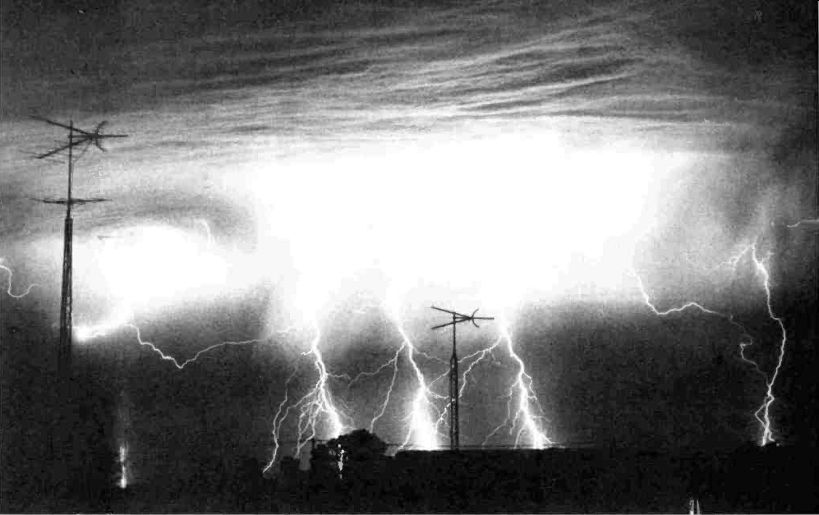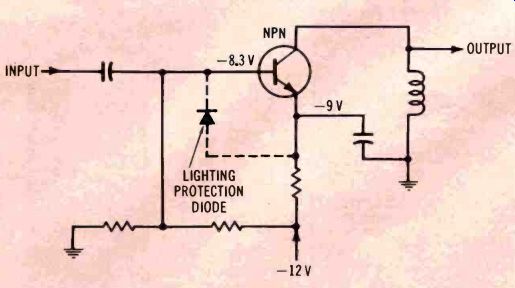Devices and circuits have been developed to protect antenna preamplifiers and MATV line amplifiers from most lightning damage.

---This spectacular lightning display silhouetted two Winegard antennas
against the clouds of a mid-western storm. MATV systems that do not have
proper grounding and protection for the RF transistors often fail during
similar storms. (Photograph by Tom Small, Kankakee, Illinois Daily Journal)
By James E. Kluge, technical editor, Winegard Company
When transistorized indoor and mast-mounted preamplifiers became popular several years ago, viewers were pleased by the greatly improved reception of distant or weak TV signals. However, these new preamps sometimes stopped operating for no apparent reason.
Many such preamps were found to have shorted transistors, and investigators discovered that lightning caused the failures. Because of their closeness to antenna and cable, these preamps and MATV line amplifiers were susceptible to damage from lightning. Obviously, some kind of protection was needed.
A direct lightning strike can destroy virtually any or all components, such as transistors, circuit boards, other parts and even the coaxial cable. No known protective system can totally prevent this type of extreme damage.
Instead, the research centered on methods of protecting the input transistor from lightning that produces no visible burned paths, vaporized components, or other obvious destruction.
Although the primary protection today is furnished by a unique diode (Figure 1) at the transistor input, other advances have contributed to the present good dependability.
High-pass filters
Although the principal energy in a bolt of lightning is dc power, each bolt is accompanied by many (perhaps thousands of) random RF pulses that radiate a substantial amount of energy in all directions.
Much of this energy (or the higher harmonics of it) falls within the frequencies occupied by TV signals, and it produces noise streaks across the TV picture.
Some transistor failures can be prevented by including sharp-cutoff high-pass filters that reduce the amplitude of frequencies below 54MHz (where lightning power is greatest) before the combined signal plus noise pulses reach the first transistor.
These noise pulses extend even into the UHF band, but at reduced amplitude. Therefore, UHF amplifiers need only high-pass filters and improved transistors for protection.
Amplifiers for VHF (where lightning-caused failures are more likely) require extra protection.
Improved transistors
RF-amplifier transistors have been improved enormously over the years. Gain has been increased while cross-modulation was decreased, noise figures have been reduced and the transistors now can withstand larger input and collector voltages without failures.
These enhanced characteristics also have decreased the possibility of failures from lightning discharges.
In general, high-frequency transistors experience a breakdown above 3 to 5V of peak base/emitter reverse voltage. However, transistors of high-voltage ratings typically can withstand up to between 5 and 8V before breakdowns occur.
Translated into actual circuits, this says junction breakdowns probably will result from a negative pulse of greater than 8V between base and emitter. If the junction cannot dissipate the energy fast enough, the resulting heat destroys the junction causing a base/emitter short that ruins the transistor and eliminates all gain. When this happens, the picture disappears into the snow.
Protective diode
Noise pulses of forward-bias polarity produce transistor base-to emitter conduction that reduces the amplitude below the damage point.
However, other protection is required against reverse-bias (negative with NPN transistors) pulses. After extensive lab and field tests, Winegard engineers have produced an effective method of protecting pre-amps and line amps at reasonable cost.
A diode having the ability to turn on and off very rapidly is connected between base and emitter of the RF transistor (Figure 2). Notice that the diode polarity is reversed from that of the transistor.
This is a special planar-epitaxial diode that combines the required high-speed operation with low capacitance and high internal power dissipation. Only noise pulses of steep rise times can come through the input filters. Therefore, the protective diode must turn on fast enough to prevent the instantaneous reverse-bias voltage from exceeding the breakdown point. Also, conduction must stop rapidly to prevent loss of the TV signal following the noise pulse. This diode is rated at 2ns recovery time, and the maximum reverse leakage current is only 50uA. Fast switching of the diode prevents the transistor reverse-bias from exceeding about 2V. Low capacitance is necessary to prevent impedance changes, high VSWR or detuning when the diode is connected. Maximum internal capacitance of this protective diode is 2pF. Also, the protective diode must be capable of dissipating the full pulse power.
Each model of VHF amplifier that is developed in the Winegard engineering laboratory must be able to withstand rapidly repetitive 40kV fast-rise-time pulses without damage. These lab tests indicate that protection has been achieved, and reports from areas having many severe lightning storms seem to confirm this conclusion.
Therefore, unless they receive a direct strike of lightning, properly designed preamps and line-amps should operate dependably during electrical storms.

Figure 1---Special diodes used to protect Winegard antenna preamps and
MATV line amplifiers are about the size of small power-supply diodes.

Figure 2---The protective diode is connected between base and emitter
of the first RF transistor, as shown in the simplified schematic.
Also see: Case studies: Eliminating RF interference